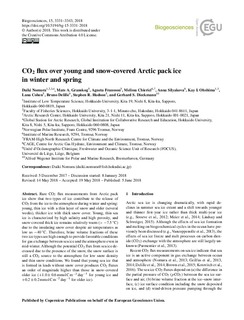| dc.contributor.author | Nomura, Daiki | |
| dc.contributor.author | Granskog, Mats A. | |
| dc.contributor.author | Fransson, Agneta | |
| dc.contributor.author | Chierici, Melissa | |
| dc.contributor.author | Silyakova, Anna | |
| dc.contributor.author | Ohshima, Kay | |
| dc.contributor.author | Cohen, Lana | |
| dc.contributor.author | Delille, Bruno | |
| dc.contributor.author | Hudson, Stephen R. | |
| dc.contributor.author | Dieckmann, Gerhard | |
| dc.date.accessioned | 2018-08-01T11:13:05Z | |
| dc.date.available | 2018-08-01T11:13:05Z | |
| dc.date.created | 2018-06-07T16:20:18Z | |
| dc.date.issued | 2018 | |
| dc.identifier.citation | Biogeosciences. 2018, 15 3331-3343. | nb_NO |
| dc.identifier.issn | 1726-4170 | |
| dc.identifier.uri | http://hdl.handle.net/11250/2507110 | |
| dc.description.abstract | Rare CO2 flux measurements from Arctic pack ice show that two types of ice contribute to the release of CO2 from the ice to the atmosphere during winter and spring: young, thin ice with a thin layer of snow and older (several weeks), thicker ice with thick snow cover. Young, thin sea ice is characterized by high salinity and high porosity, and snow-covered thick ice remains relatively warm (> −7.5 ◦C) due to the insulating snow cover despite air temperatures as low as −40 ◦C. Therefore, brine volume fractions of these two ice types are high enough to provide favorable conditions for gas exchange between sea ice and the atmosphere even in mid-winter. Although the potential CO2 flux from sea ice decreased due to the presence of the snow, the snow surface is still a CO2 source to the atmosphere for low snow density and thin snow conditions. We found that young sea ice that is formed in leads without snow cover produces CO2 fluxes an order of magnitude higher than those in snow-covered older ice (+1.0 ± 0.6 mmolCm−2 day−1 for young ice and +0.2 ± 0.2 mmolCm−2 day−1 for older ice). | nb_NO |
| dc.language.iso | eng | nb_NO |
| dc.title | CO2 flux over young and snow-covered Arctic pack ice in winter and spring | nb_NO |
| dc.title.alternative | CO2 flux over young and snow-covered Arctic pack ice in winter and spring | nb_NO |
| dc.type | Journal article | nb_NO |
| dc.type | Peer reviewed | nb_NO |
| dc.description.version | publishedVersion | nb_NO |
| dc.source.pagenumber | 3331-3343 | nb_NO |
| dc.source.volume | 15 | nb_NO |
| dc.source.journal | Biogeosciences | nb_NO |
| dc.identifier.doi | 10.5194/bg-15-3331-2018 | |
| dc.identifier.cristin | 1589834 | |
| dc.relation.project | Norges forskningsråd: 240639 | nb_NO |
| cristin.unitcode | 7431,20,0,0 | |
| cristin.unitname | Oseanografi og klima | |
| cristin.ispublished | true | |
| cristin.fulltext | original | |
| cristin.qualitycode | 1 | |
